Knorr-Bremse Bundle
How did Knorr-Bremse revolutionize transportation?
Delve into the Knorr-Bremse SWOT Analysis and discover the fascinating
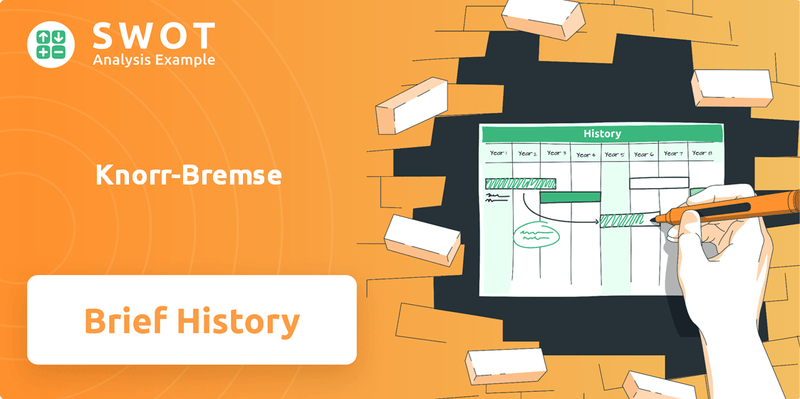
This
What is the Knorr-Bremse Founding Story?
The story of the Knorr-Bremse company began on March 11, 1905, in Berlin, Germany. Georg Knorr, an engineer, established the company with a clear vision: to revolutionize railway braking systems. His engineering expertise was crucial in identifying and addressing the limitations of existing technologies.
Knorr recognized the need for more effective braking solutions as trains became faster and heavier. This led to the development of advanced pneumatic braking systems. The company's initial success was built on its innovative products, which significantly improved railway safety and operational efficiency. This marked the beginning of the Knorr-Bremse history.
The company's early funding came from Georg Knorr himself and likely from early investors who saw the potential in this growing industry. The name, Knorr-Bremse, directly reflects its founder and core business, signaling its focus on brake technology. The timing of its founding was ideal, coinciding with significant industrial and railway development in Germany, providing a strong foundation for Knorr-Bremse company.
Georg Knorr founded the company in 1905 with the goal of improving railway braking systems. His engineering background allowed him to identify and solve the safety issues of the time. The company's initial product was the Knorr single-chamber compressed-air brake.
- Knorr-Bremse was founded on March 11, 1905, in Berlin, Germany.
- Georg Knorr, an engineer, saw the need for better braking systems for trains.
- The company’s first major product was the Knorr single-chamber compressed-air brake.
- The company's name reflects its founder and core business.
Knorr-Bremse SWOT Analysis
- Complete SWOT Breakdown
- Fully Customizable
- Editable in Excel & Word
- Professional Formatting
- Investor-Ready Format
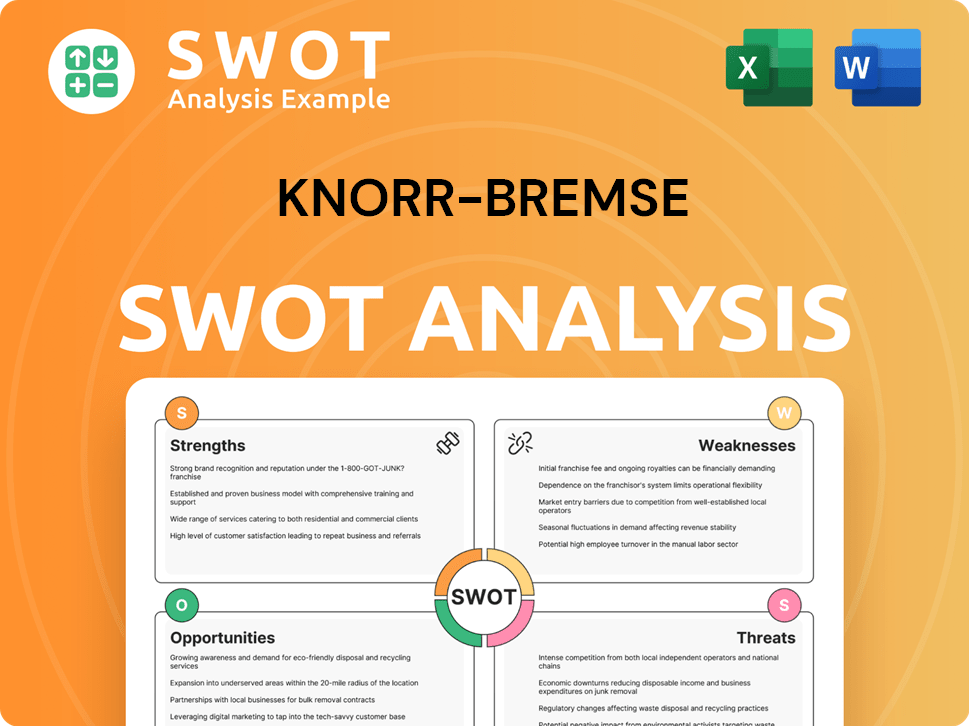
What Drove the Early Growth of Knorr-Bremse?
The early growth of the Knorr-Bremse company was marked by rapid expansion, fueled by its innovative braking systems. Following the success of its initial compressed-air brake, the company continued to refine and introduce new technologies for rail vehicles. This focus on quality and innovation facilitated a swift expansion beyond Germany. Early international subsidiaries were a key step in establishing a global footprint for the Knorr-Bremse company.
Following the initial success of its single-chamber compressed-air brake, Knorr-Bremse expanded its product offerings. This included the development of more advanced braking systems tailored for rail vehicles. The company's focus on innovation allowed it to meet the evolving needs of the transportation sector, driving further growth in the early years.
Knorr-Bremse quickly gained traction with major clients like German railway companies. The company's reputation for reliability and efficiency supported its expansion beyond Germany. By the 1920s, Knorr-Bremse had established a presence in countries like Austria and Hungary, marking a significant step in its global expansion.
A significant milestone in the Knorr-Bremse history was the establishment of its first international subsidiaries. The company's growth was largely organic, driven by continuous innovation and strong market demand. Georg Knorr guided the company through its formative years, solidifying its technological leadership in the transportation industry. You can learn more about the Revenue Streams & Business Model of Knorr-Bremse.
The market reception for Knorr-Bremse's products was overwhelmingly positive, addressing critical safety and efficiency needs. Its solutions allowed it to navigate the competitive landscape effectively. This early success solidified Knorr-Bremse's position as a key player in the rapidly evolving transportation sector.
Knorr-Bremse PESTLE Analysis
- Covers All 6 PESTLE Categories
- No Research Needed – Save Hours of Work
- Built by Experts, Trusted by Consultants
- Instant Download, Ready to Use
- 100% Editable, Fully Customizable
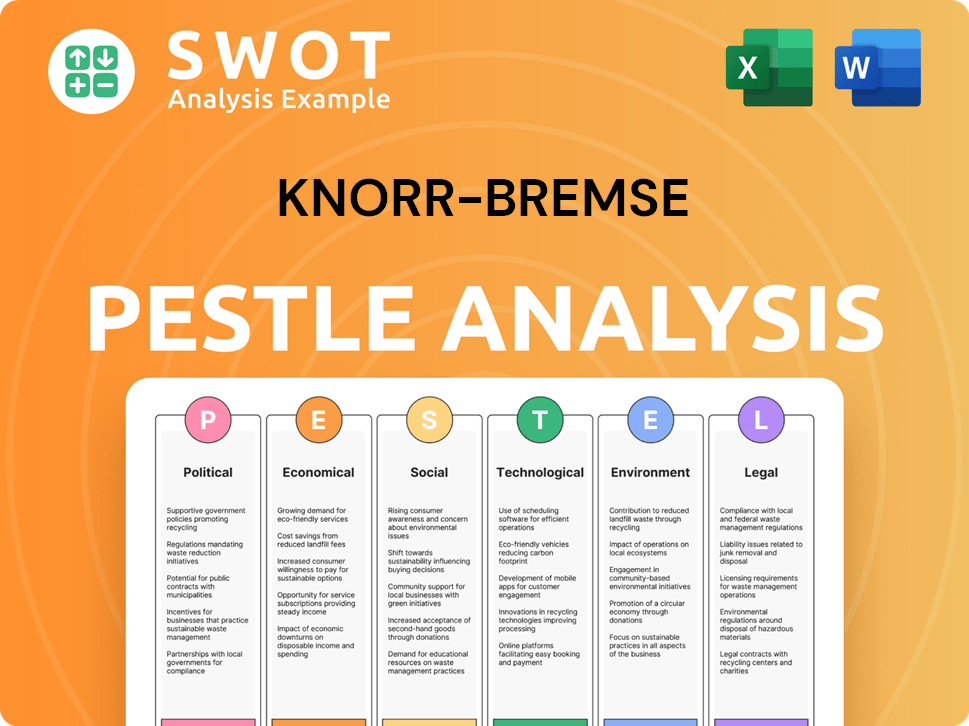
What are the key Milestones in Knorr-Bremse history?
The Knorr-Bremse history is marked by significant achievements and strategic shifts that have propelled the Knorr-Bremse company to its current position. From its early days to the present, the Knorr-Bremse has consistently adapted and innovated within the automotive and rail industries.
| Year | Milestone |
|---|---|
| 1905 | Georg Knorr-Bremse founder establishes the company in Berlin, initially focusing on railway brake systems. |
| 1920s | The company pioneers the development of pneumatic braking systems for commercial vehicles, expanding its market reach. |
| 1970s | Knorr-Bremse introduces anti-lock braking systems (ABS) for commercial vehicles, setting an industry standard. |
| 1980s | Electronic braking systems (EBS) are developed, further enhancing safety and performance. |
| 2024 | Knorr-Bremse acquires a majority stake in companies to expand its portfolio in areas like autonomous driving and electric commercial vehicle technology. |
Knorr-Bremse has consistently been at the forefront of technological advancements in braking systems. These innovations have not only improved safety but have also enhanced the efficiency of both rail and commercial vehicles.
The introduction of pneumatic braking systems in the 1920s marked a significant expansion beyond rail applications. This innovation broadened the company's market significantly.
Knorr-Bremse developed ABS for commercial vehicles in the 1970s, a crucial advancement in vehicle safety. This technology helped prevent wheel lock-up during braking.
EBS, introduced in the 1980s, enhanced braking performance and vehicle stability. EBS provided more precise control and responsiveness.
Recent investments in digitalization and e-mobility solutions reflect the company's adaptation to new industry trends. These solutions include advanced driver assistance systems (ADAS).
Knorr-Bremse is actively involved in developing technologies for autonomous driving. This includes advanced braking and steering systems.
The company is expanding its portfolio to include solutions for electric commercial vehicles. This includes braking systems and related components.
The Knorr-Bremse timeline has been marked by several challenges, including economic downturns and the impact of major world events. The company has consistently responded to these challenges through strategic restructuring and innovation.
The company faced economic challenges early in the 20th century. These challenges required strategic adjustments to maintain stability.
World War II significantly impacted production facilities. The company undertook extensive rebuilding efforts post-war to re-establish its capabilities.
Knorr-Bremse has faced competition from other global suppliers. The company has responded by focusing on innovation and strategic partnerships.
Adapting to increasingly stringent environmental regulations has been a key challenge in recent years. The company is investing in sustainable solutions.
The transition towards electric and autonomous vehicles presents both challenges and opportunities. Knorr-Bremse is strategically investing in these areas.
Managing complex global supply chains is an ongoing challenge. The company is focusing on optimizing its supply chain operations.
For a deeper dive into the competitive landscape, consider reading about the Competitors Landscape of Knorr-Bremse.
Knorr-Bremse Business Model Canvas
- Complete 9-Block Business Model Canvas
- Effortlessly Communicate Your Business Strategy
- Investor-Ready BMC Format
- 100% Editable and Customizable
- Clear and Structured Layout
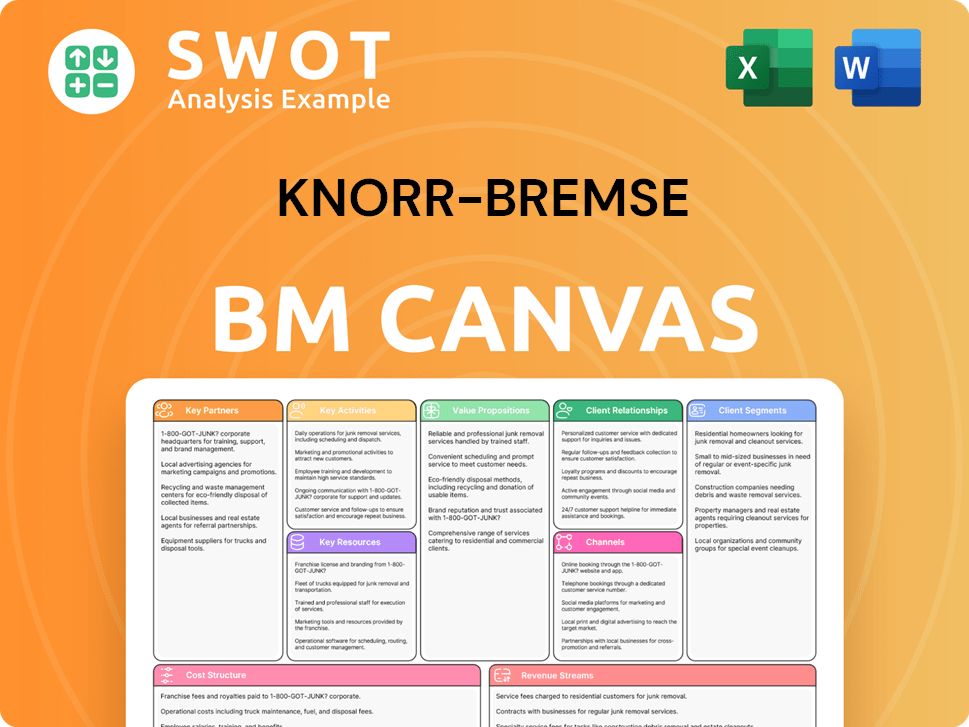
What is the Timeline of Key Events for Knorr-Bremse?
The Knorr-Bremse company has a rich history, marked by significant technological advancements and strategic expansions. Founded in Berlin by Georg Knorr in 1905, the company quickly became a pioneer in braking systems, developing and introducing pneumatic braking systems in the 1920s. Over the decades, Knorr-Bremse has consistently innovated, introducing anti-lock braking systems (ABS) in the 1970s and electronic braking systems (EBS) in the 1980s. A pivotal moment was the 1990 acquisition of the commercial vehicle brake division from AlliedSignal (Bendix), which significantly boosted its global footprint. The 2000s saw expansion into new areas, such as door systems and HVAC for rail vehicles, and in 2019, the company enhanced its financial flexibility by listing on the Frankfurt Stock Exchange. In 2023, Knorr-Bremse reported approximately EUR 7.9 billion in Group sales, with operating EBIT around EUR 1,069 million, showcasing its strong market position. Furthermore, in 2024, the company continued its strategic investments in autonomous driving and e-mobility solutions, including a stake acquisition in a related company.
| Year | Key Event |
|---|---|
| 1905 | Georg Knorr founded Knorr-Bremse AG in Berlin. |
| 1920s | Knorr-Bremse developed and introduced pneumatic braking systems for commercial vehicles. |
| 1970s | The company introduced anti-lock braking systems (ABS) for commercial vehicles. |
| 1980s | Knorr-Bremse launched electronic braking systems (EBS). |
| 1990 | Acquisition of the commercial vehicle brake division from AlliedSignal (Bendix) occurred. |
| 2000s | Knorr-Bremse expanded into new product areas for rail vehicles. |
| 2019 | Successful listing on the Frankfurt Stock Exchange was achieved. |
| 2023 | Knorr-Bremse reported approximately EUR 7.9 billion in Group sales. |
| 2024 | Continued strategic investments in autonomous driving and e-mobility solutions were made. |
Knorr-Bremse is significantly investing in digitalization and e-mobility, recognizing these as key trends. This includes developing advanced driver-assistance systems and solutions for electric vehicles. The company aims to expand its portfolio to meet the evolving needs of the market, particularly in the areas of automated driving functionalities. These initiatives are central to Knorr-Bremse's future strategy.
The company has set ambitious sustainability targets, including achieving carbon neutrality in its own operations by 2030. This commitment aligns with broader industry goals to reduce environmental impact. Knorr-Bremse is focusing on sustainable technologies and solutions within its product offerings. These efforts are integral to its long-term strategy and brand image.
Knorr-Bremse is focused on strengthening its position in the global rail and commercial vehicle markets. The company is actively expanding its presence in key regions, including Asia and North America. The company is leveraging innovation to address emerging market needs. This expansion is supported by ongoing infrastructure projects and fleet modernization efforts.
Analyst predictions indicate continued strong demand for Knorr-Bremse's core products. The company's strong financial results in 2023, with Group sales around EUR 7.9 billion, provide a solid foundation. Strategic investments in new technologies are expected to drive future growth. Leadership emphasizes a commitment to innovation and sustainable mobility solutions.
Knorr-Bremse Porter's Five Forces Analysis
- Covers All 5 Competitive Forces in Detail
- Structured for Consultants, Students, and Founders
- 100% Editable in Microsoft Word & Excel
- Instant Digital Download – Use Immediately
- Compatible with Mac & PC – Fully Unlocked
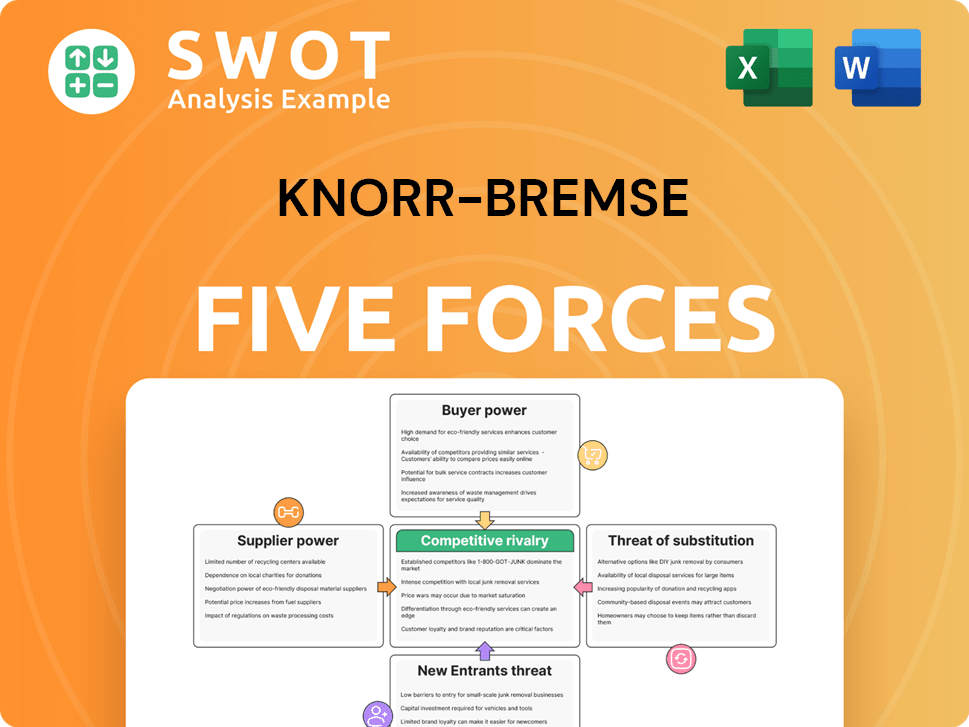
Related Blogs
- What is Competitive Landscape of Knorr-Bremse Company?
- What is Growth Strategy and Future Prospects of Knorr-Bremse Company?
- How Does Knorr-Bremse Company Work?
- What is Sales and Marketing Strategy of Knorr-Bremse Company?
- What is Brief History of Knorr-Bremse Company?
- Who Owns Knorr-Bremse Company?
- What is Customer Demographics and Target Market of Knorr-Bremse Company?
Disclaimer
All information, articles, and product details provided on this website are for general informational and educational purposes only. We do not claim any ownership over, nor do we intend to infringe upon, any trademarks, copyrights, logos, brand names, or other intellectual property mentioned or depicted on this site. Such intellectual property remains the property of its respective owners, and any references here are made solely for identification or informational purposes, without implying any affiliation, endorsement, or partnership.
We make no representations or warranties, express or implied, regarding the accuracy, completeness, or suitability of any content or products presented. Nothing on this website should be construed as legal, tax, investment, financial, medical, or other professional advice. In addition, no part of this site—including articles or product references—constitutes a solicitation, recommendation, endorsement, advertisement, or offer to buy or sell any securities, franchises, or other financial instruments, particularly in jurisdictions where such activity would be unlawful.
All content is of a general nature and may not address the specific circumstances of any individual or entity. It is not a substitute for professional advice or services. Any actions you take based on the information provided here are strictly at your own risk. You accept full responsibility for any decisions or outcomes arising from your use of this website and agree to release us from any liability in connection with your use of, or reliance upon, the content or products found herein.